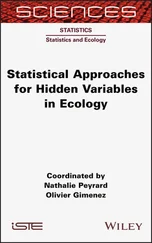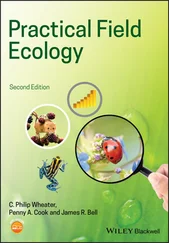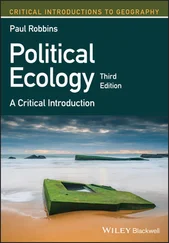what is the size of a modular population?
It follows from this that in modular organisms, the number of surviving zygotes (individuals in a genetic sense) can give only a partial and misleading impression of the ‘size’ of the population. Kays and Harper (1974) coined the word genet to describe this ‘genetic individual’ – the product of a zygote – and we can see that in modular organisms, the distribution and abundance of genets is important, but it is often more useful to study the distribution and abundance of modules (ramets, shoots, tillers, zooids, polyps or whatever). The amount of grass in a field available to cattle is not determined by the number of genets but by the number of leaves (modules).
4.2.2 Growth forms of modular organisms
We can see how modular organisms grow by taking higher plants as a good example. The fundamental module of construction above ground is the leaf with its axillary bud (the bud emerging where the leaf meets the stem) and the attendant section of stem. As the bud develops and grows, it produces further leaves, each bearing buds in their axils. The plant grows by accumulating these modules. At some stage in the development, a new sort of module appears, associated with reproduction (flowers in higher plants) and ultimately giving rise to new zygotes. Such specialised reproductive modules usually cease to give rise to new modules. The programme of development in modular organisms is typically determined by the proportion of modules that are allocated to different roles (e.g. to reproduction or to continued growth).
Depending on how they grow, modular organisms may broadly be divided into those that concentrate on vertical growth, and those that spread their modules laterally, over or in a substrate. Among plants that mostly extend laterally, many produce new root systems at intervals along the lateral stem: these are the rhizomatous and stoloniferous plants. The connections between the parts of such plants may die and rot away, so that the product of the original zygote becomes represented by physiologically separated parts. (Modules with the potential for separate existence are known as ‘ramets’.) The most extreme examples of plants ‘falling to pieces’ as they grow are the many species of floating aquatics like duckweeds ( Lemna ) and the water hyacinth ( Eichhornia ). Whole ponds, lakes or rivers may be filled with the separate and independent parts produced by a single zygote.
Trees are the supreme example of plants whose growth is concentrated vertically. The peculiar feature distinguishing trees and shrubs from most herbs is the connecting system linking modules together and connecting them to the root system. This does not rot away, but thickens with wood, conferring perenniality. Most of the structure of such a woody tree is dead, with a thin layer of living material lying immediately below the bark. The living layer, however, continually regenerates new tissue, and adds further layers of dead material to the trunk of the tree. This solves, by the strength it provides, the difficult problem of obtaining water and nutrients below the ground, but also light, perhaps 50 m away at the top of the canopy.
modules within modules
We can often recognise two or more levels of modular construction. The strawberry ( Figure 4.1c) is a good example of this: leaves are repeatedly developed from a bud, but these leaves are arranged into rosettes. The strawberry plant grows (i) by adding new leaves to a rosette and (ii) by producing new rosettes on stolons grown from the axils of its rosette leaves. Trees also exhibit modularity at several levels: the leaf with its axillary bud, the whole shoot on which the leaves are arranged, and the whole branch systems that repeat a characteristic pattern of shoots.
Many animals, despite variations in their precise method of growth and reproduction, are as ‘modular’ as any plant. And in corals, for example, just like many plants, the individual may exist as a physiologically integrated whole, or may be split into a number of colonies – all part of one individual, but physiologically independent (Hughes et al ., 1992).
4.2.3 Senescence – or the lack of it – in modular organisms
There is also often no programmed senescence of whole modular organisms – they appear to have perpetual somatic youth (see Thomas (2013) for a review of senescence, and its avoidance, in plants). Even in trees that accumulate their dead stem tissues, or gorgonian corals that accumulate old calcified branches, death often results from becoming too big or succumbing to disease rather than from programmed senescence. We see evidence of this in Figure 4.2, which shows how rates of mortality and birth vary with age in a wide variety of organisms. It is a figure to which we will return several times in this chapter. For now, we can note that there are a number examples there, indeed of trees and a gorgonian coral, in which there is no evidence of the increases in mortality at older ages that we see in organisms that senesce, like ourselves.

Figure 4.2 Compilation of patterns of mortality (survivorship) and reproduction from across the plant and animal kingdomsfrom reproductive maturity to the age where only 5% of the adult population is still alive. To emphasise variations in pattern, mortality and fertility are scaled relative to their means. Survivorship is plotted on a log scale. The plots are arranged in order of decreasing mortality at the terminal age. Note the marked contrast between organisms like ourselves (top line) that show senescence, where there is a marked increase in mortality in old age, and those like the coral and oak tree in the bottom line where there is no such increase. This is part of a more general variation in the shape of survivorship curves, picked up again in Figure 4.11.
Source : After Jones et al . (2014).
At the modular level, things are quite different. The annual death of the leaves on a deciduous tree is the most dramatic example of senescence – but roots, buds, flowers and the modules of modular animals all pass through phases of youth, middle age, senescence and death. The growth of the individual genet is the combined result of these processes. Figure 4.3, for example, shows that the age structure of leaves of the perennial herb, Wedelia trilobata , a native of central America, is changed dramatically by the application of nitrogen fertiliser. Plants are larger when they are more heavily fertilised, and the rate at which they ‘give birth’ to leaves is greater, but so too is the death rate of those leaves.

Figure 4.3 The growth of a genet reflects the births and deaths of its component modules.(a) Numbers of leaves of plants of Wedelia trilobata (means of six plants), divided into seven‐day age classes, cultivated at low (above) and high (below) nitrogen availability. Bars are SEs. At high nitrogen availability, the plants are not only larger: they also have a much higher proportion of young leaves. (b) The cumulative number of newly produced (above) and dead (below) leaves in the same study. The high proportion of young leaves at high nitrogen (HN) availability seen in (a) is the result of both birth and death rates of leaves being higher. LN, low nitrogen.
Source : After Suarez (2016).
Читать дальше














